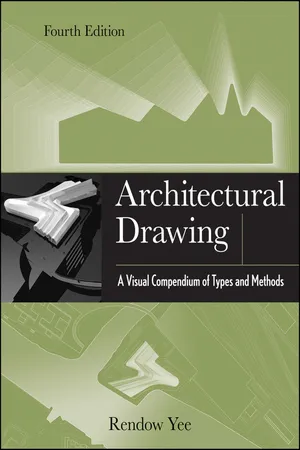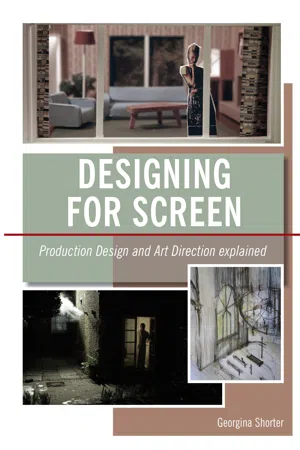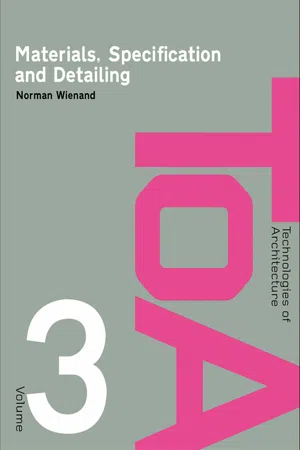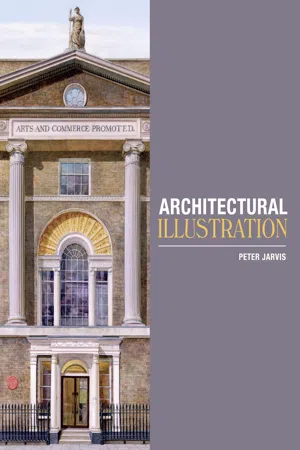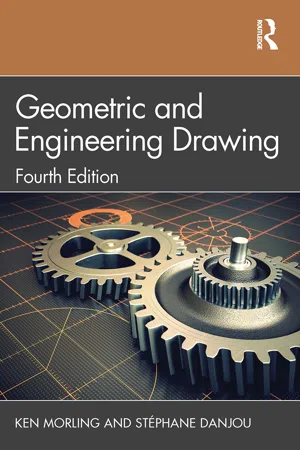Technology & Engineering
Isometric Drawing
Isometric drawing is a method of visually representing three-dimensional objects in two dimensions. It uses a set of three equal angles to depict the object's height, width, and depth without distortion. This technique is commonly used in technical and engineering drawings to provide a clear and accurate representation of objects and their dimensions.
Written by Perlego with AI-assistance
8 Key excerpts on "Isometric Drawing"
Learn about this page
Index pages curate the most relevant extracts from our library of academic textbooks. They’ve been created using an in-house natural language model (NLM), each adding context and meaning to key research topics.
- eBook - ePub
- Roy A. Parisher(Author)
- 2011(Publication Date)
- Gulf Professional Publishing(Publisher)
Chapter 13. Piping IsometricsAn extensive discussion of the need for, and development of, piping Isometric Drawings is provided. How piping isometrics are created from plan and elevation views is explained. The use of a north arrow in establishing pipe orientation and routing on the isometric is shown graphically. The fitting, flange, and valve drawing symbols unique to isometrics are depicted. The use of coordinate and elevation callouts to determine configuration dimensions of the routed pipe is explained. The visualization, representation and dimensioning of single, multi-angle and rolling offsets is explained. Dimensional solutions of various pipe lengths using Pythagorean theorem and various trigonometric formulas are presented.Keywordsangular offset; bill of materials; drawing symbols; feet and inch to decimal conversion chart; isometric dimensions; material takeoff; multi-angle offsets; north arrow; Pythagorean theorem; rise; roll; rolling offsets; run; shop spool; travel; trigonometric formulas; turning pointWhat is an Isometric?
An isometric is a type of three-dimensional drawing known as a pictorial. Isometrics, or isos as they are commonly called, are developed using the three primary dimensions of an object: height, width, and depth. Unlike orthographic drawings that represent the height, width, and depth dimensions in separate views (see Figure 13.1 ), the isometric combines the three dimensions of the object into a single view to provide a pictorial representation of the object (see Figure 13.2 ). To include the height, width, and depth dimensions in a single view, an isometric must be drawn on axes that measure 30° from the horizontal plane, as shown in Figure 13.2 .Figure 13.1 Orthographic views. Figure 13.2 Isometric view. Like the front, Top, and Right Side views in Figure 13.1 , Piping Plans, Sections, and Elevations offer limited visualization of an object, especially when piping components like fittings, flanges, or valves are incorporated. However, by combining the height, width, and depth dimensions found on Plan, Section, or Elevation views, a single pictorial view can result in a drawing that provides greater clarity of the piping configuration. A comparison between the orthographic views shown in Figure 13.3 and the isometric in Figure 13.4 - eBook - ePub
Architectural Drawing
A Visual Compendium of Types and Methods
- Rendow Yee(Author)
- 2012(Publication Date)
- Wiley(Publisher)
As with the previous drawings, this frontal elevation oblique (also termed a 0º planometric) does not create the illusion of the third dimension. This type of drawing allows us to see vertical dimensions, fenestration patterns, and the roof structure configuration or plan layout simultaneously.CONSTRUCTING Isometric DrawingS
Isometric, when literally translated, means “equality of measurement.” True lengths parallel to any of the orthographic axes will be the same as in the Isometric Drawing. An Isometric Drawing is not composed of true angles, whereas plan oblique drawings do have true angles. Isometric bird’s-eye views create the illusion of parallel lines, when in reality the lines are converging. Your eyes tend to lead you to the corner of the building mass.The isometric drawing is one of the most important types of axonometric drawings. Principles for its construction are as follows:- The axes (AX and AY) on the ground plane are always drawn 30° from the horizontal.
- Measure all orthographic distances along the three axes AX, AY, and AZ, and only along these axes.
- Any lines that are not along the isometric axes (inclined or nonaxial lines) should be located and measured by locating the end points of the line (see a’-a). These lengths will not be the same in the isometric view and the orthographic views.
- Parallel lines in an orthographic drawing remain parallel in the corresponding Isometric Drawing.
- Vertical lines in an orthographic drawing remain vertical in an Isometric Drawing.
- Hidden lines are normally not drawn in an isometric, but they can be used to help visualization.
- Corner points may be labeled in each orthographic view and in the isometric view to help visualize the Isometric Drawing.
- One disadvantage of the isometric is that it cannot use the orthographic view in the actual orthographic (plan/elevation) layout.
When projected on the picture plane, the three axes are always 120° apart. Conventionally and for simplicity, the two non-vertical axes are constructed 30° to a horizontally drawn line. - eBook - ePub
Designing for Screen
Production and Art Direction Explained
- Georgina Shorter(Author)
- 2012(Publication Date)
- Crowood(Publisher)
Different form and dimensional information is available with each view. To get a true physical understanding of the object’s dimensional surface area, it must be drawn in a series of flattened views or elevations without perspective distortion. It needs to show the true measurements of height, width and depth. Using solid lines for visible form and broken lines for the hidden, you should have all the key information you need. Depending on the object, there are three or six regular views (known as multi-views) of an object that provide all the relevant information. These are:• Top view. • Front view. • Right side view. • Left side view. • Rear view. • Plan or bottom view.Task 2: Orthographic Projections of a Chair
Figures 80 to 85 show each view of a chair. Using solid lines for visible form and broken lines for hidden form, draw six orthographic projections of the chair.Fig. 80 Top view.Fig. 81 Front view.Fig. 82 Right side view.Fig. 83 Left side view.Fig. 84 Rear view.Fig. 85 Bottom view.Understanding the breakdown of a 3-D object and interpreting it accurately in two dimensions gives the Designer the basis of knowledge for all technical drawing.Isometric DrawingS
Isometric Drawings differ from orthographic drawings , as they are 3-D drawings on paper that show three sides of an object or space in true proportion . No corner is shown at 90 degrees and all horizontal lines are always drawn at 30 degrees from the determined baseline, with all vertical lines remaining true or perpendicular. An isometric drawing can be created using the information from a technical drawing, which makes it ideal for showing interiors (see Fig. 86 ). These drawings can be drawn by hand or on screen.Fig. 86 Isometric sketch.DRAFTING LANGUAGE
Technical drawing uses the principles of orthographic projection to communicate an object or an environment’s true form and dimension. Each view provides an accurately scaled and dimensionally correct footprint of the surface plane. In addition to this, each drawing provides detailed construction and design information, including surface detail and types of construction material. The most regularly used views are the plan view, elevation, and section and cross-section views (see Fig. 87 ).Task 3: Draw an Object Showing Three or Six Views
Select an asymmetrical object and, following the same method as above, considering whether the object requires three views or multi-views and draw them on screen or by hand.Fig. 87 Technical drawing showing plan and elevations views. - eBook - ePub
Engineering Technologies
Level 2
- Mike Tooley(Author)
- 2016(Publication Date)
- Routledge(Publisher)
Prints. Hard copy, both black and white and colour, can be produced easily when and where required. Manually produced drawings must be scanned or photocopied, which reduces quality and introduces errors.Orthographic drawing
Engineering drawings are normally produced by a technique known as orthographic drawing. The word orthographic means to draw at right angles and it is derived from the Greek words orthos, meaning straight, rectangular and upright, and graphos meaning written down. Orthographic drawing techniques allow us to represent three-dimensional solids on a two-dimensional surface so that all the dimensions are true length and all the surfaces are true shape. To achieve this when surfaces are inclined to the vertical or the horizontal we have to use auxiliary views, but more about these later. Let’s keep things simple for the moment.Engineers use two orthographic drawing techniques, either first-angle or third-angle projection. The former is also called English projection and the latter is sometimes known as American projection. You need to be familiar with both of these techniques.First-angle projection
Figure 4.5a shows a simple component drawn as a 3D object (known as an isometric view). Figure 4.5b shows the same component as an orthographic drawing. This time we make no attempt to represent the component pictorially. Each view of each face is drawn out separately either full size or to the same scale. What is important is how we position the various views as this determines how we view and understand the drawing.The views in the first angle projection shown in Figure 4.5 are arranged as follows:• Elevation. This is the main view from which all the other views are positioned. You look directly at the side of the component and draw what you see.Figure 4.5 An isometric view and its corresponding first-angle projection.• Plan. To draw this, you look directly down on the top of the component and draw what you see below the elevation.• End view. This is sometimes called an end elevation - eBook - ePub
Materials, Specification and Detailing
Foundations of Building Design
- Norman Wienand(Author)
- 2007(Publication Date)
- Taylor & Francis(Publisher)
Planometric or plan oblique (axonometric) is where a plan is drawn to full orthographic detail but offset to 45°, i.e. with one corner facing the viewer and vertical elements extended upwards.- Isometric projection is based on 30° angles and produces the most realistic of paraline drawings with all the dimensions drawn using the correct scaled sizes.
- CAD has not led to much development in the way technical information is portrayed but much is possible including interactive 3D visualisation.
Passage contains an image
Chapter 6Specification writing conventions
As we have seen, the conventional communication process in technical design is based on a fairly efficient process. Traditionally, this process provides accurate drawings with accompanying written information in the form of specification notes. These notes can be found on the drawing itself or in a separate document, and they may also rely on formal specification systems such as the NBS.This chapter will examine the aims of specifications and the ways in which they attempt to convey information by describing the performance required or by the exact description of a product or detail. The value and difficulties in writing specifications from first principles will be contrasted with those associated with the use of standardised systems. Part 5 will examine all aspects of specification writing in detail, but this section aims to look at it primarily as a communication tool.It has been acknowledged that drawings have limits to the amount of information they can convey and that some form of words can aid the process of communication. This is particularly true in the area of quality. The drawing of a high-quality object can look identical to a poorer version. This is not always the case, however, as high-quality elements would normally be apparent by the extent of the detailed drawn information provided. In practice, however, it is the added text that defines the quality required. - eBook - ePub
- Peter Jarvis(Author)
- 2018(Publication Date)
- Crowood(Publisher)
Orthographic projection is the main convention for representing the plan, elevation and section of a building and is a single-plane drawing. This means that measurements can be taken from this type of drawing, although not in a single view. Each projection is drawn to a stated scale and is in true proportion.Orthographic projections include plans, elevations and sections, and in order to give a complete picture of 3D form these need to be seen together. An imagined image can then be formed by those familiar with the convention used. As the dominant method of formal representation, orthographic drawings combine pictorial elements with accuracy and as such are accepted as legal documents in the evidence of proposed built form. There are two types of projections: first angle and third angle. To understand both methods you need to imagine the object in question floating inside a transparent box. In first angle, each elevation is viewed from the front and then projected onto the side of the box behind. With third angle the elevation is viewed in the same way but projected onto the side in front of it. In both cases the ‘boxes’ can be unfolded flat to reveal the elevations in position on each of the six faces.Axonometric drawingAxonometric drawing uses the scale and, in the case of isometric , the measurability of orthographic drawing but in a single view using three dimensions. The axonometric view offers an infinite number of angles but without converging parallels; it is only isometric that gives a true scale in each direction.Axonometric means ‘to measure along axes’ and includes isometric, diametric, trimetric and oblique projections and each type uses parallel projection. With isometric, each of the three axes of the object is drawn 120° apart (or 30° left and 30° right to the horizontal) with one axis vertical. All measurements are true lengths or scaled equally. In diametric projection the two horizontal axes are equal angles with related foreshortening and the vertical axis is considered separately. With trimetric projection each axis is at a different angle, each with relative foreshortening. Oblique projections have one angle between two axes at 90° and the other two at 135° each, again, with relative foreshortening. Other than isometric, each projection can be adapted and used to suit a particular viewpoint and given foreshortening relative to each axis. - eBook - ePub
- Ken Morling, Stéphane Danjou(Authors)
- 2022(Publication Date)
- Routledge(Publisher)
Figure 4.13 shows a small stepped pulley drawn twice in oblique projection. It is obvious that the drawing on the left is easier to draw than the one on the right.4.4 AXONOMETRIC PROJECTION (ISOMETRIC AND DIMETRIC)
Another method of parallel projection is orthographic projection. In contrast to oblique projection where the projectors are at any angle other than 0° or 90°, in orthographic projection (ortho = right) all projectors are perpendicular to the plane of projection (Figure 4.14 ). There are two methods of orthographic projection. One is called multi-view projection and is used for engineering drawings. The other one, axonometric projection, is used to create pictorial drawings.Engineering drawings are usually drawn in multi-view projection, whose principles are explained in the subsequent section. For the presentation of detailed drawings, this system has been found to be far superior to all others. The system has, however, the disadvantage of being very difficult to understand by people not trained in its usage. It is always essential that an engineer be able to communicate his or her ideas to anybody, particularly people who are not engineers, and it is therefore an advantage to be able to draw using a system of projection that is more easily understood such as an axonometric projection.Figure 4.13A drawing of a stepped pulley.An axonometric projection is a projection method where a pictorial view is created by rotating the object on one of its axes, relative to the projection plane. In this way all three dimensions can be shown. However, not all of them are shown in true size (Figure 4.15 ).Axonometric projections can be further classified by the angles between the axonometric axes. When all angles are equal, the projection is classified as isometric projection. When two of the three angles are equal, the projection is referred to as dimetric. When none of the three angles differ in size, the projection is called trimetric - eBook - ePub
- Roger Timings(Author)
- 2007(Publication Date)
- Routledge(Publisher)
5 Engineering drawing
When you have read this chapter you should understand how to: • Interpret (read) drawings in first and third angle projection. • Sketch and dimension mechanical components in first and third angle projection. • Sketch mechanical components in isometric and oblique projection.5.1 Engineering drawing (introduction)
Figure 5.1 (a) shows a drawing of a simple clamp. This is a pictorial drawing. It is very easy to see what has been drawn, even to people who have not been taught how to read an engineering drawing. Unfortunately such drawings have only a limited use in engineering. If you try to put all the information that is required to make the clamp onto this drawing it would become very cluttered and difficult to interpret. Therefore we use a system called orthographic drawing when we make engineering drawings.Figure 5.1 Clamp: (a) pictorial drawing; (b) orthographic drawing; (c) fully dimensioned in millimetresAn example of an orthographic drawing of our clamp is shown in Fig. 5.1 (b). We now have a collection of drawings each one looking at the clamp from a different direction. This enables us to show every feature of the clamp that can be seen and also some things that cannot be seen (hidden details). Features that cannot be seen are indicated by broken lines. Finally we can add the sizes (dimensions) that we need in order to make the clamp. These are shown in Fig. 5.1 (c). A drawing that has all the information required to make a component part, such as Fig. 5.1 (c), is called a detail drawing, but more of that later.5.2 First angle orthographic drawing
There are two systems of orthographic drawing used by engineers: • First angle or English projection. • Third angle or American projection.In this section we are going to look at first angle projection. We are again going to use the clamp you first met in Fig. 5.1

